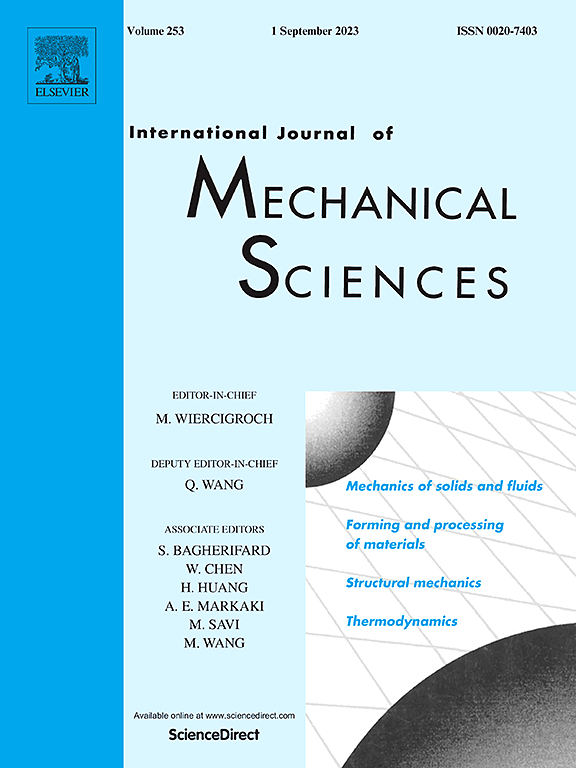Clarifying the viscous relaxation mechanism for twisting carbon nanotube ribbons
IF 7.1
1区 工程技术
Q1 ENGINEERING, MECHANICAL
International Journal of Mechanical Sciences
Pub Date : 2025-06-22
DOI:10.1016/j.ijmecsci.2025.110522
引用次数: 0
Abstract
Twisted carbon nanotube (CNT) fibers have emerged as promising candidates for actuators and artificial muscles due to their excellent mechanical properties, offering significant potential in mechanical engineering and intelligent medical applications. Despite this promise, the effects of twisting on the viscous mechanical behavior of CNT fibers and their composites, particularly the evolution of their microstructure and time-dependent relaxation behavior, remain insufficiently understood. This study addresses this gap by conducting single and multiple stress relaxation experiments on untwisted ribbons and twisted CNT fibers. The findings reveal greater stress relaxation in CNT ribbons compared to twisted fibers, attributed to the microstructural constraints introduced by twisting. A viscoelastic model was developed to accurately capture the experimental stress-time curves and provide theoretical derivations of the stress-strain relationships for CNT ribbons and fibers. Additionally, numerical simulations elucidate the underlying viscous mechanisms, demonstrating that the intrinsic viscosity driving stress relaxation governs the time-dependent stress behavior and strain-rate sensitivity of the assembly. The study further highlights the critical role of twisting in shaping relaxation behavior, emphasizing the influence of enhanced interface interactions. Loading-unloading experiments on single and quadruple CNT fibers reveal that interface constraints significantly affect stress relaxation and rate sensitivity, offering new insights into the interplay between microstructural dynamics and mechanical performance. This work advances our understanding of the time-dependent properties of CNT fibers and provides a foundation for designing high-performance CNT-based materials for long-term applications.

阐明了碳纳米管扭曲带的粘性松弛机制
扭曲碳纳米管(CNT)纤维由于其优异的机械性能,在机械工程和智能医疗应用方面具有巨大的潜力,已成为执行器和人造肌肉的有希望的候选者。尽管有这样的前景,但扭转对碳纳米管纤维及其复合材料粘性力学行为的影响,特别是其微观结构的演变和随时间变化的松弛行为,仍然没有得到充分的了解。本研究通过在未扭曲的碳纳米管带和扭曲的碳纳米管纤维上进行单次和多次应力松弛实验来解决这一空白。研究结果表明,与扭曲纤维相比,碳纳米管带状中的应力松弛更大,这归因于扭曲引入的微观结构约束。建立了粘弹性模型,以准确地捕捉实验应力-时间曲线,并提供了碳纳米管带和纤维应力-应变关系的理论推导。此外,数值模拟阐明了潜在的粘性机制,表明固有粘性驱动应力松弛控制着组件的随时间应力行为和应变率敏感性。该研究进一步强调了扭转在形成弛豫行为中的关键作用,强调了增强的界面相互作用的影响。单根和四根碳纳米管纤维的加载-卸载实验表明,界面约束显著影响应力松弛和速率敏感性,为微观结构动力学和力学性能之间的相互作用提供了新的见解。这项工作促进了我们对碳纳米管纤维时间相关特性的理解,并为设计长期应用的高性能碳纳米管基材料提供了基础。
本文章由计算机程序翻译,如有差异,请以英文原文为准。
求助全文
约1分钟内获得全文
求助全文
来源期刊

International Journal of Mechanical Sciences
工程技术-工程:机械
CiteScore
12.80
自引率
17.80%
发文量
769
审稿时长
19 days
期刊介绍:
The International Journal of Mechanical Sciences (IJMS) serves as a global platform for the publication and dissemination of original research that contributes to a deeper scientific understanding of the fundamental disciplines within mechanical, civil, and material engineering.
The primary focus of IJMS is to showcase innovative and ground-breaking work that utilizes analytical and computational modeling techniques, such as Finite Element Method (FEM), Boundary Element Method (BEM), and mesh-free methods, among others. These modeling methods are applied to diverse fields including rigid-body mechanics (e.g., dynamics, vibration, stability), structural mechanics, metal forming, advanced materials (e.g., metals, composites, cellular, smart) behavior and applications, impact mechanics, strain localization, and other nonlinear effects (e.g., large deflections, plasticity, fracture).
Additionally, IJMS covers the realms of fluid mechanics (both external and internal flows), tribology, thermodynamics, and materials processing. These subjects collectively form the core of the journal's content.
In summary, IJMS provides a prestigious platform for researchers to present their original contributions, shedding light on analytical and computational modeling methods in various areas of mechanical engineering, as well as exploring the behavior and application of advanced materials, fluid mechanics, thermodynamics, and materials processing.
 求助内容:
求助内容: 应助结果提醒方式:
应助结果提醒方式:


